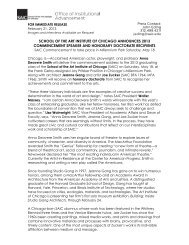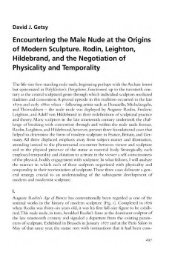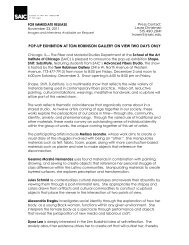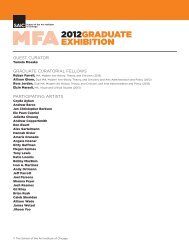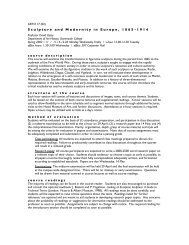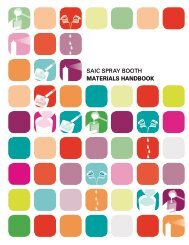i. institutional support and commitment to continuous improvement
i. institutional support and commitment to continuous improvement
i. institutional support and commitment to continuous improvement
Create successful ePaper yourself
Turn your PDF publications into a flip-book with our unique Google optimized e-Paper software.
School of the Art Institute of Chicago<br />
Department of Architecture, Interior Architecture, <strong>and</strong> Designed Objects<br />
Master of Architecture<br />
Master of Architecture with emphasis in Interior Architecture<br />
To deliver an education that embodies creativity, social responsibility, his<strong>to</strong>rical perspectives,<br />
technical competence, environmental consciousness, ethical imagination, <strong>and</strong> an underst<strong>and</strong>ing<br />
of current global economic <strong>and</strong> social changes. To educate students <strong>to</strong> become innovative<br />
transdisciplinary design leaders, in the disciplines of architecture, interior architecture, <strong>and</strong><br />
designed objects.<br />
The faculty of AIADO feel strongly that many different interpretations of design are entering public<br />
discourse <strong>and</strong> are evolving <strong>and</strong> converging in a fast changing world where designers need <strong>to</strong> be<br />
comfortable with uncertainty <strong>and</strong> complexity—often having <strong>to</strong> locate their creative imagination in<br />
paradoxical opportunities outside the traditional boundaries of design. Art, design, science, <strong>and</strong><br />
entrepreneurial business are teaming <strong>to</strong> create new pro<strong>to</strong>cols <strong>and</strong> information flows. With the social<br />
shaping of technology, out-dated bureaucratic mechanisms are breaking down around alternative<br />
environmental, social, <strong>and</strong> political sensibilities. Design is at the core of these changes in translating<br />
thought in<strong>to</strong> the more tangible. The academy responds with significant alternatives in education <strong>and</strong>,<br />
through collaborative partnerships, a network of informed personalities contribute <strong>to</strong> the design of<br />
our changing world—making it dense, fluid, <strong>and</strong> dynamic. How designers explore this complexity is by<br />
definition a highly creative act of design.<br />
At the School of the Art Institute of Chicago <strong>and</strong> through the programs in AIADO, the faculty<br />
encourage <strong>and</strong> practice a vibrant engagement with design. They believe that future designers need<br />
<strong>to</strong> be thinking designers—willing <strong>to</strong> explore unknown terri<strong>to</strong>ry <strong>and</strong> engage problems not yet defined,<br />
taking risks while confident enough <strong>to</strong> find opportunity in failure. Deep explorations in the studio<br />
context are required where the art of thinking <strong>and</strong> making translate in<strong>to</strong> the ineffable: at the very<br />
intersection of art, design, <strong>and</strong> architecture. Explorations that are useful beyond the realm of design<br />
add significant meaning <strong>to</strong> environments across all scales. These explorations challenge the fluid<br />
borderline that defines the spatial, the world of objects, <strong>and</strong> the many opportunities in cognitive<br />
<strong>and</strong> non-cognitive environments yet <strong>to</strong> be explored. Play <strong>and</strong> risk are taken seriously. The faculty<br />
values freedom but expects accountability. With the rigor of thinking flowing from this philosophical<br />
approach, the School is encouraging a new kind of relevance for future designers <strong>and</strong> architects.<br />
The AIADO department launches future individual voices that are willing <strong>to</strong> lead in the fast mutating<br />
cultural l<strong>and</strong>scapes—changing the field from the inside out while connecting past traditions with future<br />
possibilities.<br />
D) His<strong>to</strong>ry of the Program<br />
The MArch program may only be four years old, but its innovative relationship <strong>to</strong> design <strong>and</strong> space<br />
has a long his<strong>to</strong>ry. In 1941 Marya Lilien began teaching the first evening classes in interior architecture<br />
at SAIC. Her students—taught on the principles Lilien had acquired while studying with Frank Lloyd<br />
Wright at Taliesin—learned <strong>to</strong> build from the inside out, creating spaces that were functional, beautiful,<br />
<strong>and</strong> well integrated. By 1945, a new Department of Interior Architecture was established. Its curriculum<br />
involved a year of general foundation studies, followed by three years of four design sessions <strong>and</strong> two<br />
technical sessions per week. The latter sessions included descriptive geometry, vital for delineating<br />
objects in space, <strong>and</strong> the course became a magnet for sculpture students as well as design students.<br />
Drafting, Perspective, Ana<strong>to</strong>my of Interiors, <strong>and</strong> the His<strong>to</strong>ry of Furniture were all taught by Lilien, who<br />
was a one-woman department for most of her tenure at the School. With its fundamentally sound<br />
principles, the curriculum remained fairly constant over the next two decades.<br />
With Marya Lilien’s retirement in 1968, the existing department was renamed Environmental Design,<br />
with some changes in curriculum as befit the times. New faculty, most significantly John Kurtich,<br />
in Interior Architecture as well as faculty in Design <strong>and</strong> Performance areas adopted the goal of<br />
Architecture Program Report | 8



